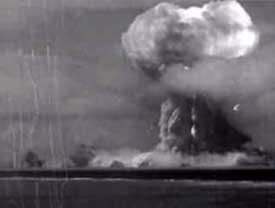 The title of the US War Department's propaganda film Special Delivery (1946) is about about the delivery of "special" weapons like atomic bombs, or rare penetrating parachutists, defined as "peace power" in the language of Newspeak such as Orwell spoke about.
The title of the US War Department's propaganda film Special Delivery (1946) is about about the delivery of "special" weapons like atomic bombs, or rare penetrating parachutists, defined as "peace power" in the language of Newspeak such as Orwell spoke about.
In general it is a pump-piece that generically praises the armed forces' airplanes & air pilots covering distances rapidly whether to get injured soldiers swiftly to hospitals, or get General Patton swiftly from place to place.
We dont' hear about many peacetime uses that aren't actually related to the military, but one example we do get is the use of government planes to spray large areas with DDT. Yay!
An interesting aside is the praise for helicoptors which the narrator notes are never used for combat, the film being too old to have predicted the fundamental value combat helicopters would have in Viet Nam. A number of interesting airplanes are catalogued including the bizarre "flying wing."
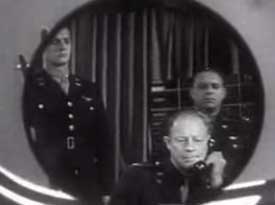 After about five minutes of general praise for airplanes in all uses, the focus for the remaining six or seven minutes is mainly on the use of airplanes to eradicate Nagasaki & Hiroshima. After about five minutes of general praise for airplanes in all uses, the focus for the remaining six or seven minutes is mainly on the use of airplanes to eradicate Nagasaki & Hiroshima.
Such pride of destruction comes complete with lingering racism of calling the Japanese "Japs," & glory-be prise for the use of airplanes to assist in the atomic bomb tests of the Bikini Atoll (Operation Crossroads), which is called "a bombadier's dream target."
Delivering atomic bombs appears to be the thing that most matters in this military pride film about air power, & "peaceful" use for "science" is epitomized by making the Bikini islands uninhabitable for many decades to come.
One big lie told is "all precautions were taken to protect military personel," then they are shown without protective garments near the flash point with only goggles to prevent the outright blindness of nearby observers.
For this depressing film, it was an important part of the disinformation campaign to show unprotected personel irradiated on purpose as evidence that it couldn't possibly be harmful.
The deadliness of the fallout, acute at Bikini, is totally ignored. Some fairly startling footage of the bomb from the decks of observation ships follows, & even a couple glimpses of the manned motion picture cameras aimed at the mushroom cloud, concluding with "Air power is Peace power!" as evidenced by mass destruction.
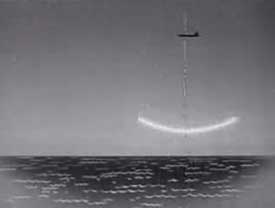 Another propoganda piece about & from the "air forces" (it was not yet a singular Air Force) was Target Invisible (1945), focusing on the importance of the then-new radar technologies in bombing Japan, both conventional bombs as in the levelling of Tokyo, & the A bombs dropped on Hiroshima & Nagasaki. Another propoganda piece about & from the "air forces" (it was not yet a singular Air Force) was Target Invisible (1945), focusing on the importance of the then-new radar technologies in bombing Japan, both conventional bombs as in the levelling of Tokyo, & the A bombs dropped on Hiroshima & Nagasaki.
It's totally gung-ho for bombing civilian populations with each "cargo of destruction." Much is made of the fact that death-dealing bombs can fulfill their mission & the soldiers never having to see their victims, which is apparently a good thing. Makes it easier at least.
It has "sciency" bits describing how radar works in very elementary terms. As the airplane is guided closer & closer to the Japanese coast by radar, the narrator lowers his voice & the Hollywood adventure-music becomes suspense-music.
In actor re-enactment the bombadier receives instructions to bomb the largest city on Fujiama, i.e., Tokyo. They make a big to-do of it being a "pin point" target of an enemy aircraft factory, though the truth was that the entire city was leveled with intentional disregard for the target being predominantly civillians.
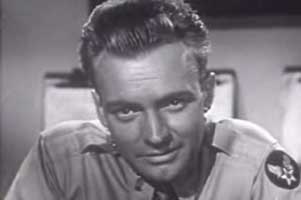 The imperfect narration gives the real point away in noting, "This is what the Jap sees. His cities, his factories, in ruins." The imperfect narration gives the real point away in noting, "This is what the Jap sees. His cities, his factories, in ruins."
By no means was it just the factories. Indeed the photographs of what "the Jap sees" are non-military sites with hardly a building left standing.
We at last get to see the narrator, holding one of those photos. He looks straight at us through the camera & am I the only one that finds his smiling smugness as spooky as in a horror film?
He says, "A lot of you out there are probably asking, well, 'Why show us this? The war's over.'" His answer begins: "We wanted to let you in on one of the big secrets of the war." Lean closer, my little droogies. "Yes you're right, the war is over, & we won it."
That was a secret?
"But now there is the matter of the peace. Our scientists must go on perfecting old inventions & developing new ones for the security of our nation."
And it concludes with a pitch to America to keeping buying War Bonds to assist in the great effort to make even the A bomb much more destructive. "How 'bout it?"
copyright © by Paghat the Ratgirl
|
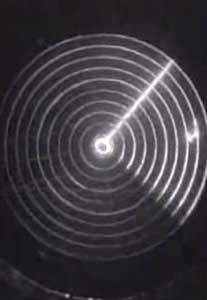

 After about five minutes of general praise for airplanes in all uses, the focus for the remaining six or seven minutes is mainly on the use of airplanes to eradicate Nagasaki & Hiroshima.
After about five minutes of general praise for airplanes in all uses, the focus for the remaining six or seven minutes is mainly on the use of airplanes to eradicate Nagasaki & Hiroshima.
 The imperfect narration gives the real point away in noting, "This is what the Jap sees. His cities, his factories, in ruins."
The imperfect narration gives the real point away in noting, "This is what the Jap sees. His cities, his factories, in ruins."